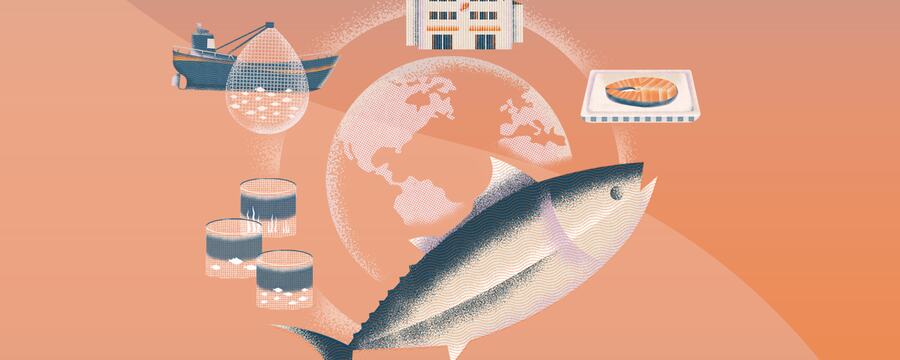Aquaculture feed: is there enough to go around?
Aquaculture is expanding at a rapid pace, but with growing production, comes growing input in the form of feed. So what are fish actually fed, and will there be enough feed to nourish all the fish we’re growing?
What do farmed fish eat?
Aquaculture involves breeding and growing fish in a captive environment. For fish farms to be productive and yield high volumes of good quality produce, the fish need to be fed a diet that fulfils their nutritional requirements.
In a farming scenario, herbivore fish subsist on feeds made from a mixture of plant-based protein like soy, vegetable oils, and mineral and vitamin supplements.[1] Carnivorous fish eat other fish in the wild and therefore, fish meal and fish oils currently make up a relatively large (roughly 30-50%) component of their diet.[1]
What is fish meal?
Fish meal is a commercially important protein-rich flour made by cooking, pressing, drying, and grinding fish and fish by-products.[2] Fish oil, obtained by pressing cooked fish and centrifuging the liquid, is also used in aquaculture feed for carnivorous fish because it provides essential natural fats and various micronutrients that fish would traditionally obtain in the wild through their diet.[2] Fish meal is an excellent source of nucleotides, essential fatty acids, and phospholipids.[3]
It also contains minerals such as calcium, phosphorus, magnesium, zinc, and iodine as well as water and fat-soluble vitamins.[3] Fish oil is a natural source of essential polyunsaturated fatty acids like eicosapentaenoic acid (EPA) and docosahexaenoicacid (DHA).[3] Both, EPA and DHA are important components of aquaculture fish’s diet because these nutrients determine the Omega-3 fatty acid content in the fish when we consume them. Ingredients that go into the feed are often combined and transformed into pellets that resemble pet food.
The largest consumers of commercial aquaculture feeds are estimated to be carp species, followed by tilapia, shrimp, catfish, and salmon.[4] A majority of commercially successful aquaculture fish are omnivorous or carnivorous and their diets therefore include fish meal and fish oil.
Nucleotides – Nucleotides are one of the structural components of DNA and RNA. A nucleotide consists of a base (one of four chemicals: adenine, thymine, guanine, and cytosine) and one molecule of sugar and phosphoric acid each.
*Phospholipids are a class of lipids whose molecules have a hydrophilic (having affinity for water) head containing a phosphate group and two hydrophobic (water repelling) tails derived from fatty acids, joined by an alcohol residue.
*Eicosapentaenoic acid is one of several omega-3 fatty acids.
*Docosahexaenoic acid is a type of omega-3 fatty acid.
*Omega-3 fatty acids are essential fats that help regulate various body functions such as producing hormones and contracting and relaxing artery walls. Omega-3 fatty acids are an important component of cell membranes.
Why are current fish feed options unsustainable?
Forage species such as herring, sardine, anchovy, and mackerel are sourced from marine waters for producing fish meal and oil. Given the steep rise in the number of aquaculture farms around the world, research indicates that our oceans may not be able to meet the feed demands of the sector in the years to come.[5,6] Besides aquaculture, these fish are highly sought-after raw material for the pet food, animal feed, pharmaceutical, and nutraceutical sectors.[2,5]
This pushes fishers to catch more fish than what is sustainable. To meet the growing demand, some fishing companies are known to use illegal methods to procure fish, such as not respecting conservation requirements and exploiting workers.
Besides exerting immense pressure on marine resources, fish meal production also impacts food security. It is estimated that around 90% of the fish used for producing fish meal are food grade and therefore fit for direct consumption by humans.[5] In developing and least developed countries, fishing companies are often tempted to export forage fish for fish meal instead of selling it for local consumption. In West Africa, for instance, an increasing volume of catches are being turned into fishmeal for export.[2] These fish have been traditionally consumed by local populations.
*Forage species, also known as bait fish, are smaller fish that are preyed on by larger species.
Are there any alternatives?
Replacing fish meal and oil in aquaculture feeds is challenging because they are the most nutritious and digestible ingredients for farmed fish.[2] However, it is clear that relying solely on ocean-sourced forage fish is not a sustainable way to meet the needs of the aquaculture sector.
Currently, 27% of all fish meal and 48% of fish oil is estimated to be produced from by-products and these numbers are expected to grow in the years to come.[2] Aquaculture farmers are also being more selective about using fish meal and oil.[2] Fish may be fed these ingredients at certain stages of the production cycle such as hatching and finishing more than the others.
Some other methods to make aquaculture feeds more sustainable have been suggested:
- Marine microalgae: Microalgae are found in abundant quantities in oceans and form a vital part of wild fish diets. When consumed live, they provide fish with nearly all essential nutrients such as polyunsaturated fats, amino acids, vitamins, and minerals.[7] Algae such as Spirulina, Chlorella sp., Scenedesmus sp., Dunaliella sp., and Nannochloropsis sp. are widely used as additives in feed for fish, prawn larvae, crustaceans, and molluscs.[7] Research on microalgae confirms that it shows the potential to completely replace fish oil in the diets of important aquaculture species such as salmon, catfish, and grouper.[3] However, the biggest bottleneck in using microalgae on a large scale is the storage and maintenance of live cultures.[7]
- Food waste: Similar to pigs and chickens, many omnivorous fish are capable of thriving on a diet composed of food scraps and leftovers. Experiments involving partial replacement of traditional feeds with food waste have shown that fish like the orange-spotted grouper and Nile tilapia adapt well to such diets.[7] Feed producers around the world have shown that suitable feed safety laws combined with animal nutrition expertise make it possible to create nutritious, safe, and sustainable feed from food waste.[8] Following the footsteps of countries such as Japan and South Korea, the European Union recently allowed waste streams containing animal-source products to be used in fish feed.[9]
- Insects: Insects are a relatively sustainable source of protein because they can be farmed using few resources and with low greenhouse gas emissions. Silkworm (Bombyx mori), black soldier fly (Hermetia illucens), housefly (Musca domestica), yellow mealworm (Tenebrio molitor), and house cricket (Acheta domesticus) are some of the most promising insects for use in aquafeed.[10]For reasons related to digestibility and amino acid composition, insect meals can only replace 30% or less fish meal in aquafeeds. However, current production levels cannot supply insect meals in large enough quantities to meet the sector’s feed requirements. Developing legal frameworks and cost-effective supply chains and production infrastructure can help close the demand and supply gap.
- Genetically modified organisms: Researchers have been working on developing plant-based feeds that can entirely replace fish meal and oil. Soybean meal is a popular ingredient in such feeds due to its high protein content but its anti-nutritional properties* do not allow wide usage. By applying bioengineering techniques, it is possible to breed soybeans that lack this anti-nutritional element.[11] It is also possible to fortify soybeans with beneficial pigments like β-carotene.[11] Other genetically modified organisms that have shown promising results for use in aquaculture feed include camelina (Camelina sativa; false flax), yeast (Yarrowia lipolytica), algae, and metabolically engineered diatom Phaeodactylum tricornutum.[3] However, genetic modification of living organisms is strictly regulated or even prohibited in most countries around the world. Implementing this technology to improve aquafeed can take several decades.
*Anti-nutritional properties: natural or synthetic compounds that interfere with the absorption of nutrients e.g. molecules of the soybean used in some fish feed can have a negative impact on fish gut health.
What does the future hold?
From the ongoing research and pilot projects, it is clear that the global aquaculture industry is aware of the consequences of relying on fish meal and oil and is striving to move towards more sustainable feed. In the years to come, we can expect to see improved techniques for the mass production of these sustainable ingredients, discovery of new ingredients, and strides in the field of fish nutrition to enable the development of better-quality feeds.[3] Given aquaculture’s critical role in feeding our growing population, this progress will play a significant role in achieving the FAO’s ‘Blue Transformation’ – a vision for sustainably transforming aquatic food systems.
Author: Madhura Rao
- Do you think factors other than feed affect aquaculture’s sustainability?
Let us know in the comments below!
Sustainable Seafood: Barriers and Opportunities in the Fishing Industry

Sustainable Seafood: Barriers and Opportunities in the Fishing Industry


Reach your personal and professional goals
Unlock access to hundreds of expert online courses and degrees from top universities and educators to gain accredited qualifications and professional CV-building certificates.
Join over 18 million learners to launch, switch or build upon your career, all at your own pace, across a wide range of topic areas.
Register to receive updates
-
Create an account to receive our newsletter, course recommendations and promotions.
Register for free







